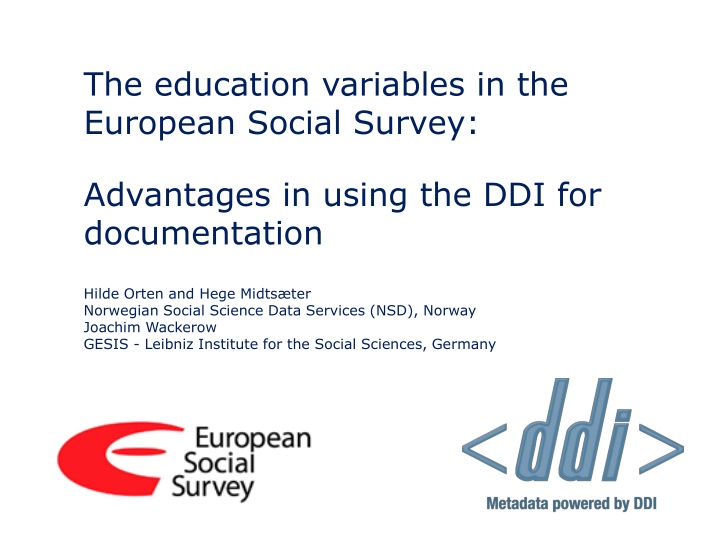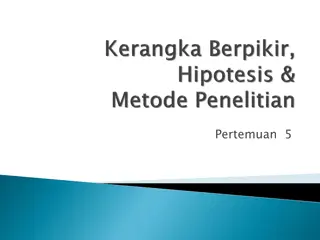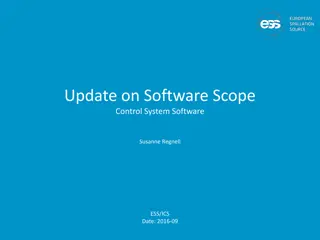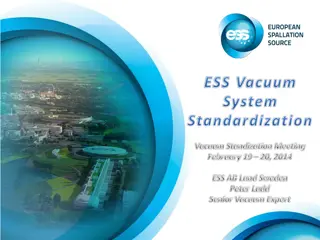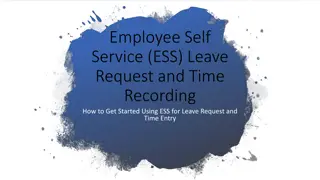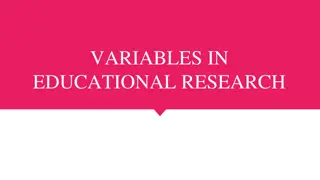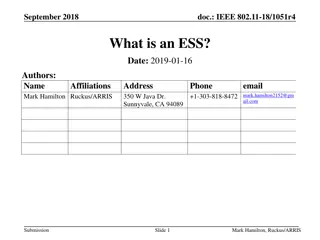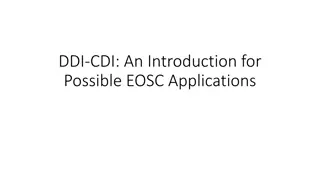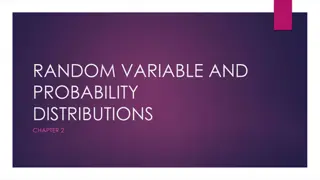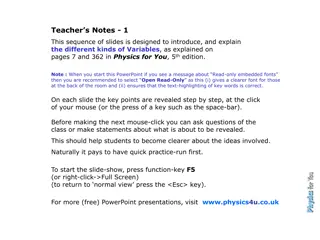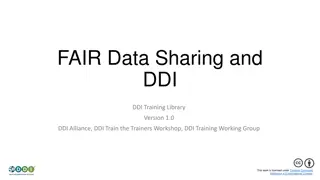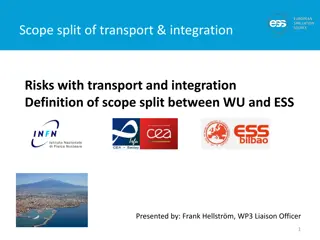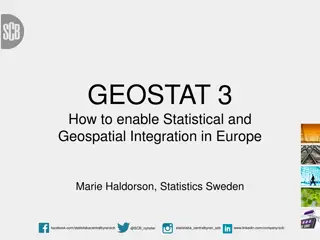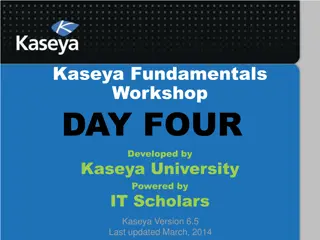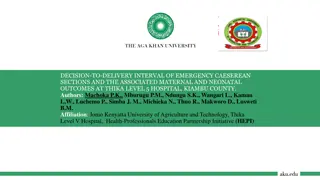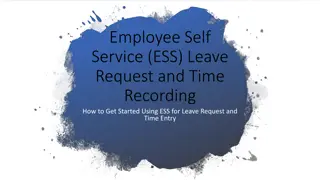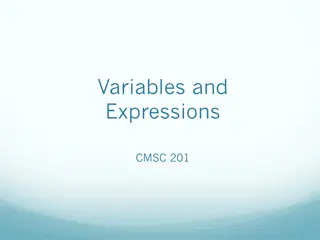Using DDI for Educational Variables in ESS
The benefits of utilizing the Data Documentation Initiative (DDI) to document education variables in the European Social Survey (ESS). Learn about DDI's role as a metadata standard in structuring and facilitating the data lifecycle for social sciences research. Discover how DDI modules enhance metadata structuring and support various aspects of the research process, from data conceptualization to archiving
Uploaded on Mar 07, 2025 | 0 Views
Download Presentation

Please find below an Image/Link to download the presentation.
The content on the website is provided AS IS for your information and personal use only. It may not be sold, licensed, or shared on other websites without obtaining consent from the author.If you encounter any issues during the download, it is possible that the publisher has removed the file from their server.
You are allowed to download the files provided on this website for personal or commercial use, subject to the condition that they are used lawfully. All files are the property of their respective owners.
The content on the website is provided AS IS for your information and personal use only. It may not be sold, licensed, or shared on other websites without obtaining consent from the author.
E N D
Presentation Transcript
The education variables in the European Social Survey: Advantages in using the DDI for documentation Hilde Orten and Hege Midts ter Norwegian Social Science Data Services (NSD), Norway Joachim Wackerow GESIS - Leibniz Institute for the Social Sciences, Germany
The DDI a metadata standard for the social sciences The education variables in the European Social Survey How could the DDI usefully be applied in the documentation of the background variables in the ESS
What is DDI - the Data Documentation Initiative? DDI is an effort to create an international standard for describing data from the social, behavioral, and economic sciences. Expressed in XML, the DDI metadata specification now supports the entire research data life cycle. DDI metadata accompanies and enables data conceptualization, collection, processing, distribution, discovery, analysis, repurposing, and archiving. A metadata structure on which to build software tools
DDI structure Module based: Modules for different purposes Modules for structuring of metadata Scheme based modules: - Contain reusable lists (schemes) of metadata elements - Follow the sequence of the data lifecycle - Form basis for the construction of concept, question or variable banks DDI a backbone for metadata structuring
Structuring of metadata in DDI allows for many possibilities Repositories DDI - Lifecycle DDI - Lifecycle Question development software Questionnaire delivery system Data Analysis software DDI - Lifecycle DDI - Lifecycle Metadata Publication
The education variables in the European Social Survey The European Social Survey is an academic driven multi country cross-sectional survey fielded every second year since 2002. - Focus on attitude and behaviour change - Rigorous standards in methodology Questions on educational attainment included from the start. Target harmonised measure, EDULVL. Standard for classification of categories, ISCED 97 Target variable had 7 categories (ISCED levels) Based on country- specific source variables
Critique and quality enhancement Critique against the education measures in the ESS: Source variable reference to construct Misclassification compared to official mappings Inconsistencies in application of ISCED criteria in mappings Some country-specific variables are not detailed enough to cover the 7 ISCED levels ISCED levels too crude coding frame for educational attainment. As a response of this critique, a Quality Enhancement meeting was held in Mannheim in 2009
ESS Quality Enhancement Meeting recommendations To implement a new, detailed, ISED based target measure. Ensure that the same concept is covered in all participating countries. Bridging specifications should be produced and made available for the national teams Upgrade the old 7 category EDULVL variables by producing a 5 category measure on the basis of the country-specific variables where possible To introduce an alternative 7 category harmonised measure with greater analytical value than the old EDULVL variable. Silke Schneider s ES-ISCED, European Survey version of ISCED was chosen
A new approach for the ISCED-based variables in the ESS NEW APPROACH: - Concept: Same concept. Definition refined - Question amended - Categories (ISCED detailed 25 + cats) - Codes: 3 digit codes - Bridging (coding) New OLD APPROACH: - Concept - Question - Categories (ISCED levels 7 cats) - Codes: 1 digit codes - Bridging (coding) UPGRADE OF DATA FROM OLD APPROACH COLLECTIONS: - Bridging (coding) Revised The new approach has resulted in three versions of the ISCED based target variable.
Variable composition in DDI Universe Concept Question Bridging (Coding) Variable Codes Categories
Three versions of the ISCED-based target variable in the ESS tn QUESTION CATEGORIES CONCEPT tn - m VARIABLE UNIVERSE CODES BRIDGING t1 QUESTION QUESTION CATEGORIES CATEGORIES CONCEPT CONCEPT VARIABLE VARIABLE UNIVERSE CODES CODES UNIVERSE BRIDGING BRIDGING
Reference of metadata elements in DDI- Lifecycle tn QUESTION CATEGORIES CONCEPT tn - m VARIABLE UNIVERSE CODES BRIDGING t1 QUESTION QUESTION CATEGORIES CATEGORIES CONCEPT CONCEPT VARIABLE VARIABLE UNIVERSE CODES CODES UNIVERSE BRIDGING BRIDGING
Comparison in DDI The following items can be compared: Concept Variables Questions Categories Codes Universes (target population for a questionnaire item) Correspondence can be described as Commonality, Difference Coded Commonality Type, Commonality Weight User Defined Correspondence Property
Compare categories: Comparable elements are mapped Reference to source and target schemes Describes how the two elements relate to another Elements can also be compared to an external standard, e.g. ISCED not completed ISCED level 1 - 000 ISCED 1, completed primary education - 113 Qualification from vocational ISCED 2C programmes of duration shorter than 2 years, no access to ISCED 3 - 129 Qualification from vocational ISCED 2C programmes of 2 years or longer duration, no access to ISCED 3 - 221 Qualification from vocational ISCED 2A/2B programmes, access to ISCED 3 vocational - 222 Qualification from general/pre-vocational ISCED 2A/2B programmes, access to ISCED 3 vocational - 212 Qualification from general ISCED 2A programmes, access to ISCED 3A general or all 3 Qualification from vocational ISCED 3C programmes of duration shorter than 2 years, no access to ISCED level 5 - 229 Qualification from vocational ISCED 3C programmes of 2 years or longer duration, no access to ISCED level 5 - 321 Qualification from vocational ISCED 3A programmes, access to 5B/lower tier 5A institutions - 322 Qualification from vocational ISCED 3A programmes, access to upper tier ISCED 5A/all ISCED level 5 institutions - 323 Qualification from general ISCED 3A/3B programmes, access to ISCED 5B/lower tier 5A institutions - 312 Qualification from general ISCED 3A programmes, access to upper tier ISCED 5A/all ISCED level 5 institutions - 313 Qualification from ISCED 4 programmes without access to ISCED level 5 - 421 Qualification from vocational ISCED 4A/4B programmes, access to ISCED 5B/lower tier 5A institutions - 422 Qualification from vocational ISCED 4A programmes, access to upper tier ISCED 5A or all ISCED level 5 institutions - 423 Qualification from general ISCED 4A/4B programmes, access to ISCED 5B/lower tier 5A institutions - 412 Qualification from general ISCED 4A programmes, access to upper tier ISCED 5A/all ISCED level 5 institutions - 413 ISCED 5B programmes of short duration, advanced vocational qualifications - 520 ISCED 5A programmes of short duration, intermediate certificate or academic/general tertiary qualification 510 ISCED 5A programmes of medium duration, qualifications at the bachelor s level or equivalent from a lower - 610 ISCED 5A programmes of medium duration, qualifications at the bachelor s level or equivalent from an upper/single - 620 ISCED 5A programmes of long cumulative duration, qualifications at the master s level or - 710 ISCED 5A programmes of long cumulative duration, qualifications at the master s level or - 720 ISCED 6, doctoral degree - 800 None of these - 999 213 0 - Not possible to harmonise into 5-level ISCED 1 - Less than lower secondary education (ISCED 0-1) 2 - Lower secondary education completed (ISCED 2) 3 - Upper secondary education completed (ISCED 3) 4 - Post-secondary non-tertiary education completed (ISCED 4) 5 - Tertiary education completed (ISCED 5-6) 55 Other QUESTION QUESTION CATEGORIES CATEGORIES CONCEPT CONCEPT VARIABLE VARIABLE UNIVERSE CODES UNIVERSE CODES BRIDGING BRIDGING
Study-independent Metadata stored in a DDI Resource package can be reused by other Studies/Waves OTHER MATERIAL NOTE CONCEPT UNIVERSE BRIDGING CATEGORIES CODES CODES QUESTION VARIABLE DDI Resource package Education/ ISCED question bank
Reusability of Metadata Items in a DDI Resource Package Implies comparability ESS Round 5 DDI Resource Package ESS Round 6 Education/ ISCED question bank Other Study
Thank you for your attention! http://www.ddialliance.org/ http://ess.nsd.uib.no/ QUESTION CATEGORIES CONCEPT VARIABLE CODES UNIVERSE BRIDGING
